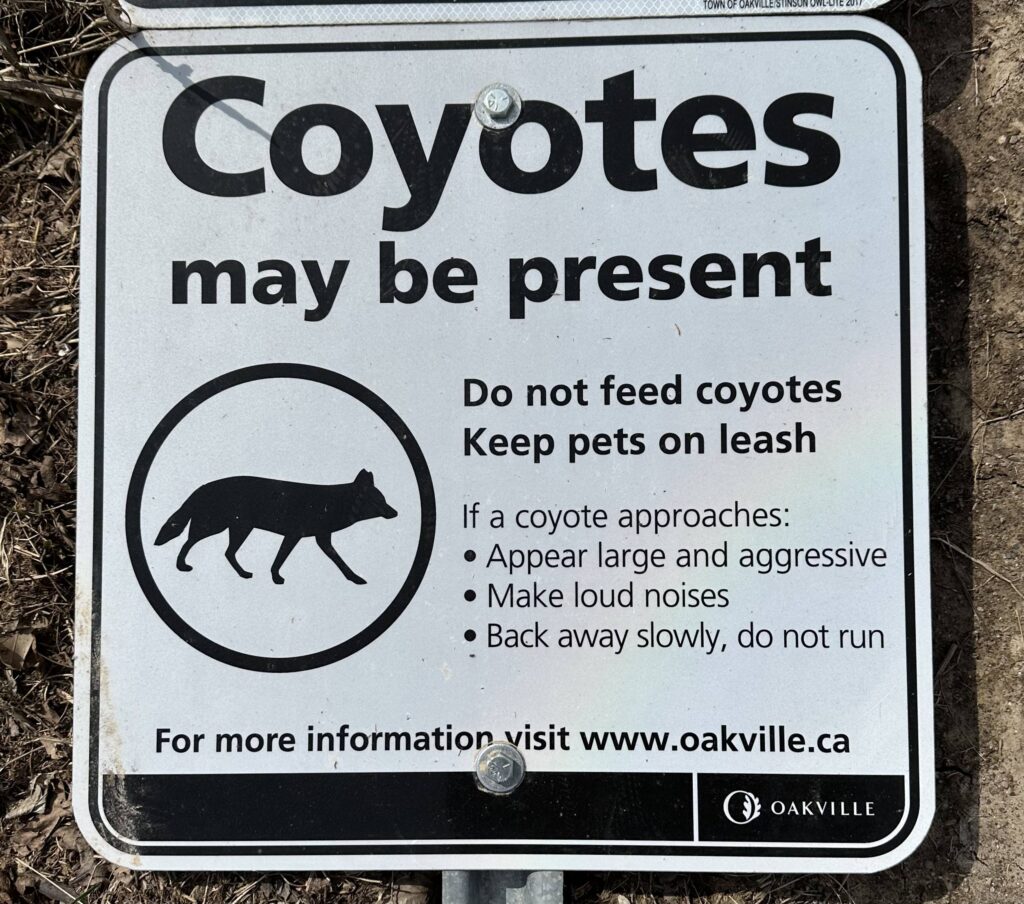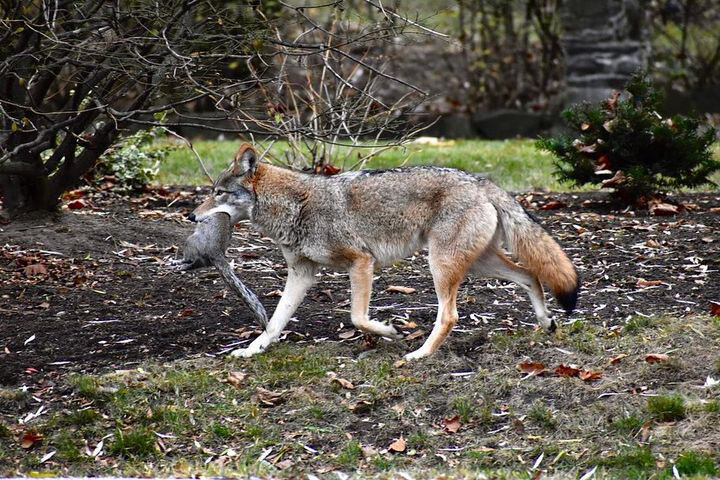By Melanie Nava Urribarri
The last rays of sun paint a thin line of amber against the indigo of the dawning night. You’re driving home after a long day. All that accompanies you is the hum of your car and the gentle wind stroking past the metal of the vehicle. The little, neon, flashing lights on the inside do nothing to distract you from the road lit up by your headlights. But one thing does.Suddenly, illuminated by the white lights, you catch a glimpse of a tapered muzzle, a black nose, slanting, yellow eyes, wide, pointed ears pricked up alert and a slim body. The fur is a grey, tawny colour. Appearing like a ghost and disappearing just as fast, uncertainty about the presence and identity of the animal lingers.
In Eastern Canada, this sight—that of an Eastern Coyote wandering about its habitat grounds— is more common in the Greater Toronto Area. However, as fascinating it is to see those gorgeous animals, it is also a sight increasingly misunderstood.
To regular citizens with little knowledge of coyote encounters, these sightings can cause fear and frustration. Not just for drivers, but anyone on a walk — especially without any guidance of how to handle this stressor.
Natasha Redekop, resident of Oakville, Ontario, describes a similar encounter as she walked her dog with a friend. “We were in the ravine and a coyote had come out and started following us. I had heard that there was a coyote den in that area and that they had had babies and so they couldn’t relocate, but it was a really high traffic path.” Redekop explains, remembering the appearance of the canine as sudden, and though alarming to her, not completely unexpected.
“So this coyote I thought was going to be aggressive or I don’t know, protecting his babies. My dog, because he’s a big dog, he thought it was another dog and wanted to play; but the coyote just kept following us until we lost it in the woods and then had to make our way back to where we knew where we were,” she adds, mentioning how she called the Human Society afterwards expecting them to be alarmed or have a plan to deal with this situation. She was told that she was in the coyote’s space and not the other way around.Talking about the coexistence of coyotes and those in the suburbs, Heather White, Community Outreach and Education Manager at the Humane Society, says that “there’s methods of hazing that you can use to discourage them from being around,” then adding that it’s not uncommon for coyotes to shadow people, “the same as if someone drove into your driveway, you might peek out the window to see who was there.”
While according to White, the Humane Society works closely with the town of Oakville to monitor such situations to ensure there are few conflicts between the coyotes and the population, there is still a fear within the people of these animals.
Fear mongering happening in the media, often wrongly paints coyotes as “aggressive” or “bad” amongst other harmful titles, explains Leslie Sampson, who is a co-founding executive director of Coyote Watch Canada as well as a consultant who has worked on behalf of canids for more than two decades. Sampson adds that coyotes are either going to be protective, defensive, territorial, or they’re demonstrating demand behaviour.
The city of Toronto reported to have received 252 reports of coyote sightings just this January, with a common narrative throughout various media of coyotes attacking dogs. The Town of Oakville itself has, updated as of 2022, posted emergency contacts and instructions posted specific for coyote encounters. You can see the white warning signs all over Oakville trails.

“I don’t ever recall seeing any coyotes. Now I live in southeast Oakville, and we have the 16-mile creek, which is probably quite a good animal viaduct, […] but I don’t ever remember seeing any coyotes previous to that in my whole lifetime of being here,” Fenton. These days, not only does she constantly hear them, but sees the corpses of their meals.

“We did have one cat that got eaten about 20 feet from our property. And yeah, they eat the insides of the cat out and they just leave the body,” said Fenton
Manager of animal services Jay Smith reported to CTV News that just in Mississauga, from 2021 to 2022, the coyote sightings rose from 1,292 to 1,452.
It can be intimidating to hear their chorus of yips and howls in the dark from your bedroom window or while on a walk, or to feel the coyote’s yellow eyes watching, but according to Sampson, hearing their calls only means communication, not danger.
Coyotes are quite intelligent and adaptable animals, mating for life and being involved parents, as well as being community animals according to Coyote Watch Canada. Unsurprisingly, colonisation itself has contributed to the attitudes towards coyotes. The Europeans brought the idea of “the big bad wolf and the wily coyote,” Sampson says, pointing out an example of Looney Tunes cartoons in which these animals are the villains. There’s an influence on the violence Europeans passed on through generations within their stories. “But at the same time, I mean, if bad mythology can be passed on, so can those good stories, such as a lot of the Indigenous creation stories with some really positive messaging out there as well,” Sampson says.
The Eastern Coyote often spotted in our urban areas is actually a species that evolved from the union between the Western coyote and the Algonquin wolf, which was formerly called the Eastern Wolf, Sampson explains. Coyotes thrive in a wide range of territory they call home, constantly moving, which creates this narrative that they are suddenly overpopulated and so we are seeing them a lot more.
“This isn’t the case. Landscape will only support a certain number of the carrying capacity of a habitat, […] so we need to really look at habitat change, farming, what we did to the landscape that opened up the land for the Western coyote to migrate here,” she adds.
All In The Wild photographer and wildlife academic Jason Bantle concurs with his perspective as a wildlife photographer whose main interest has been carnivores such as the coyote. “I think that human sprawl is really, really becoming more and more a case in Canada. We used to have a lot of wild spaces, and I think we have to be willing to realise that leaving wild spaces for animals is very important. They have rights as well,” Bantle says.
On their website, experts working with Coyote Watch Canada have compiled a list of tips for coexistence with coyotes in order to keep not just us safe, but the animal. Amongst the tips, there is “keep trash cans covered” and “supervise pets such as dogs that coyotes can consider as competition for resources.”
These seemingly small gestures go a much longer way than one may think.
In her research, Sampson has found that there are two conditioning factors that play into how coyotes behave – food and human conditioning, not a loss of fear of people. Like all wildlife, coyotes can be manipulated, corrupted, lured, baited, and betrayed by people feeding them to encourage them to come closer, which in turn might turn into repeated visits to a particular location in the community, according to Sampson. A recent incident of coyote sightings in Burlington has been linked to feeding, with the city receiving photos of food such as frozen meals being left on the trails.
In the end, as Bantle points out, we are in their habitat. He adds that “it’s important, being cognizant and very educated and aware of what animals require and their patterns.”
We’ve provided a perfect ecosystem for these animals in our cities and they are an important part of it. Coyotes eat large amounts of rodents, and through conservation estimation by Sampson, one coyote eats five rodents a day — which is close to 1800 rodents in a year.
